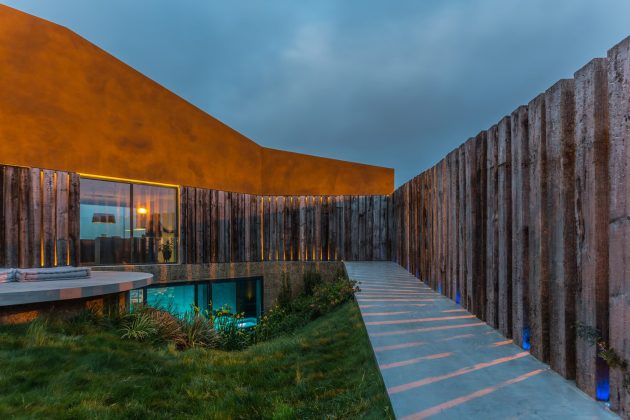Project: Casa Varatojo
Architects: Atelier Data
Location: Torres Vedras, Portugal
Area: 4,090 sf
Photographs by: Richard John Seymour
Casa Varatojo by Atelier Data
Atelier Data has designed the Varatojo House on a hilly spot located east of Torres Vedras, a city in Portugal. This fantastic contemporary residence boasts a unique exterior design with an open interior layout that delivers spectacular views.

The Varatojo House is placed on a Hill, east from the city of Torres Vedras, Portugal.
Set in a polygonal configuration plot and given its sun exposure (predominantly North/South) and also its main Northern wind direction, the design strategy began by considering the following issues: Promoting relationship between building and landscape, taking advantage of the place’s overlooking position over the city, castle and surroundings;
Encouraging a strong complementarity between the house and the garden in order to create an intense visual relation between the inside and the outside, between construction and natural elements;
Creating transversal relations between the North Side – (view) and the South side – (inner garden) mainly through the pool on the lower floor and modeling land of the garden;
Recycling of materials such as the walls of wooden pilings (former railway sleepers), introducing a certain experimentalism and innovation from the way the material is usually used for and thought to be;
Encouraging the use of native vegetation in the garden.
Design Concept
The house is shaped by a spiral gesture intending to take advantage of the plot outline.
We opted for the construction of a limit, a kind of line that gradually takes shape and thickness to accommodate the housing program.
This gesture starts with the ramped access to the lot and ends on the opposite side of the house, achieving at this point two-stories high, thereby the contour of the house also reinforced this “gesture in spiral”.
The adopted design strategy allowed us to create a living space on the site’s south side, protected from the strong Northern winds, which forced the existence of the main construction on the north side.

Program
From a functional standpoint, the program is distributed in three floors.
The groundfloor centralizes most of the program.
There is located the common areas – kitchen, living room and dining room – constrained to a single and continuous open space, enhanced by the ceilling plan. On the other hand, the rooms’ wing (with a much more restricted access) contains guest and children’s rooms, separated by a playing/studying room.
On the 1st floor is located the master bedroom with a deep balcony facing North, and on the South, there is a bathroom with a big window facing a small garden as its background.
Still on this floor there is a library, a mezzanine space over the living space.
On the lower floor the pool is the central space through where it is possible to connect with both north sights and south private garden, and also to enjoy the reflected landscape on the water.
Material Options
On one hand we opted for the use of traditional materials and coatings, as exemplified by the cementitious materials, plaster, timber and cork, and, on the other hand, we considered the reuse of railway sleepers within a distinct logic of its conventional use introducing some innovation and experimentation in the search for new possibilities of materials’ use.
Thus we suggest new interpretations from the current and traditional construction, through design but also through material options.
Vegetation: Elasticity and Plasticity
Define a grove of Quercus faginea subssp. broteroi (Portuguese oak), seeded the phytogeographic association where the plot is located. The dominant choice of native vegetation for the garden (trees, shrubs and herbaceous) takes advantage of site soil and climate characteristics, creating an ecological system integrated into the Landscape of the Region (Genius loci).
On the North hillside, a Kermes oak shrubland, appear in a limestone substrate. Exposed to the wind, the Kermes oak shrubland have as main actors the Quercus coccifera and mastic (Pistacia lentiscus) that associates with various species such as: the Mediterranean buckthorn (Rhamnus alaternus); the Flax-leaved Daphne (Daphne gnidium); the Sage-leaved Rock Rose (Cistus salvifolius); the Lusitanian gorse (Ulex densus); the Rough bindweed (Smilax aspera) and the Etruscan honeysuckle (Lonicera etrusca). On the sheltered South side, arises the Portuguese oak with arborescent shrubs like Laurustinus (Viburnum tinus); the single-seed Hawthorn (Crataegus monogyna); the Laurel (Laurus nobilis) and herbaceous like Bear`s breeches (Acanthus mollis) and yellow irises (Iris pseudacorus).































